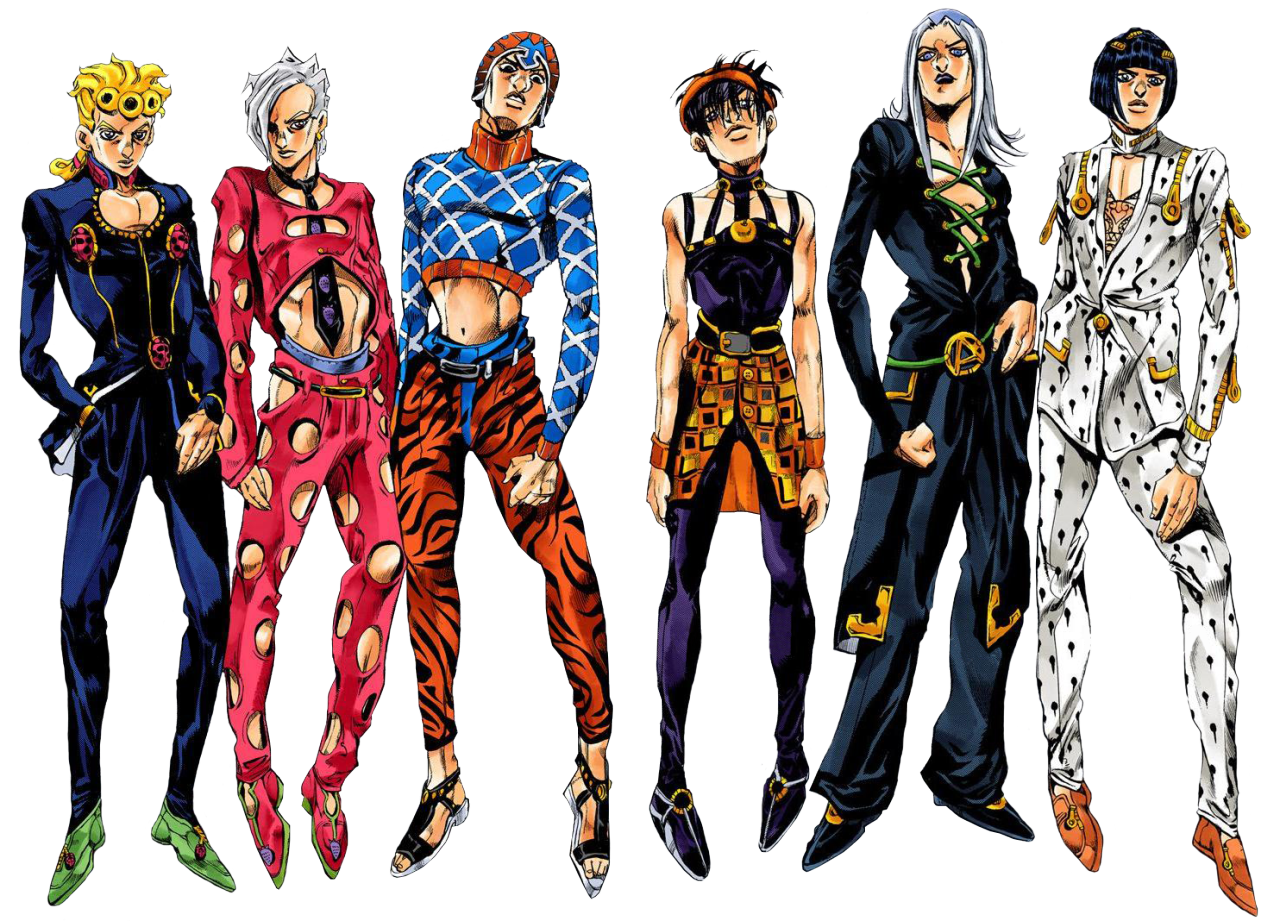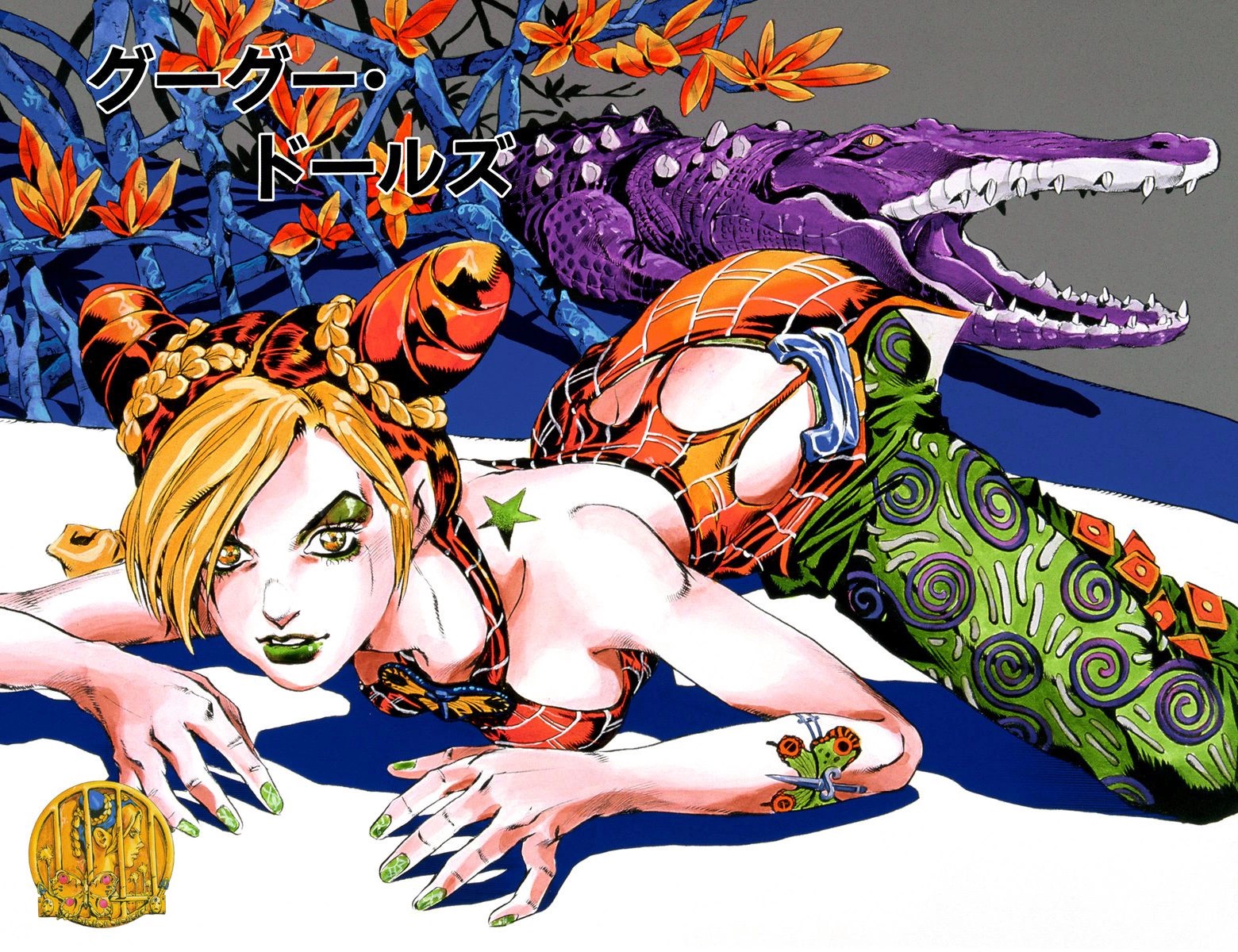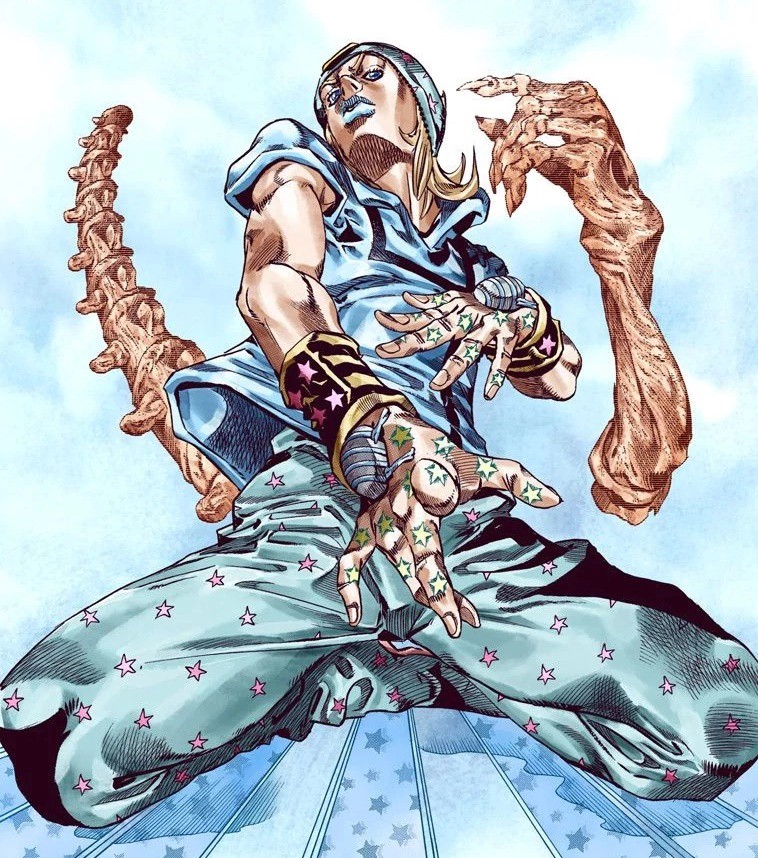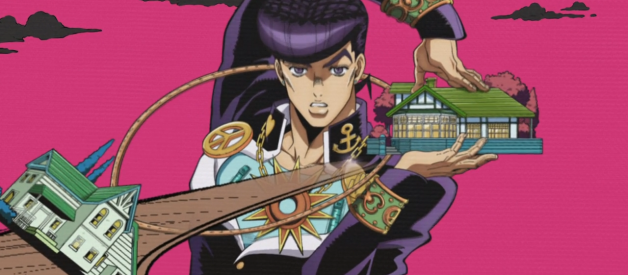
[This article has been translated into French by @CornwallBoar]
When I first watched JoJo?s Bizarre Adventure in 2012, I wasn?t out yet. I saw Jonathan Joestar, the diesel-jacked gentleman rip out of his clothes more than one time, changing into increasingly skimpier wardrobes every other two episodes. I saw vampire extraordinaire Dio Brando dress like an idiot steampunk wizard as he poisoned his foster dad before rejecting the prospect of upper-body clothing entirely (also he turned a dude into a dog at one point?). Despite the absurdity of it all, these two men weren?t afraid to cry, afraid to show affection, or even afraid to feel afraid. They were the most hyperbolised masculine pieces of meat I?d ever seen and they were emotional. Then Battle Tendency aired right after and Joseph and Caesar wore make-up and crop tops.
That same year I came out as bi. Huh.
I don?t think it?s an exaggeration to say that the men (and the women) of JoJo carry masculinity in non-conforming ways. They defy the cis-heterosexual prisons of how mascs are ought to approach body language, fashion style, and presentation. Instead, characters dress freely, move dramatically, and pose sensually! To me, a queer man, it feels like an incredibly queer show in a way I haven?t seen anywhere else. I want to investigate the possible causes of why it?s so different, and what kinds of implications it has. I assume that the reader: 1) is familiar or interested in JoJo?s Bizarre Adventure 2) has an open mind about the term ?queer masculinities? 3) doesn?t see this thesis as an obfuscation or obviation of other possible critical considerations.
My specific question is: ?What possible avenues have led JoJo?s Bizarre Adventure to arrive at a queered configuration of masculinity?? My goal here is to to try and establish a base discourse, meaning that deeper discussions of, for example, race, ethnicity, or women can feel somewhat sparse. In that light, I welcome any addendum, comment, and critique made for whatever reason!
Disclaimer: I?m not making JJBA out to be in any way revolutionary. Its queerness is the corollary of on one hand the art direction and the other the silence around its own queer factors, resulting in a paradoxical normalising effect. There are a couple of explicitly gay or bi characters (DIO, Pucci, Sorbet & Gelato) in the show, but its approaches to masculinity and queerness are only accidentally instructive, maybe because it is a-categorical.
POSES
 Caesar and Joseph acting normal and regular
Caesar and Joseph acting normal and regular
We all know the phrase ?JoJo pose? in reference to bombastic, fabulous, and near-anatomically impossible postures. A ?JoJo pose? is different than, say, a pose from more traditional masculine media like Fist of the North Star or even Rocky/Rambo. The posing in those media involves showcasing the body as a weapon: about to unleash gunfire, a knockout blow, a pressure point-press capable of exploding a skull. A JoJo pose, however, is almost never constructed as an intimidatory thing. Characters don?t move to induce fear in others or assert themselves as dominant???when they do,it?savillain. Their posturing is weird or creepy, accompanied by the katakana for ?menacing?.
A JoJo pose, then, doesn?t instrumentalise masculinity as a weapon, despite all the musculature going around. The masc body is disarmed, contrasting conventional cinematic choreography. Rather than emanating an aggression that causes a Ripple effect, the pose is the result of narrative tension that culminates in character (re)action. For example, Caesar and Joseph?s pose, in the story, is actually an expression of grief and anger! Caesar?s best friend (a literal Nazi oops) was just killed by an Aztec gym god. Witnessing this, both men instantly pose up, like it?s a natural answer to such a scenario.
In the classic buildup-climax-resolution structure of drama, the JoJo pose is not the climax. A crucial moment has already happened when characters assume their stances. That?s why I think it?s part of the resolution. The message the body language sends out is a responsive one, a formulation of certain emotions that don?t cause but are caused. This drama, transposed onto the masculine body, becomes an expressive display and an emotive affect. It gets treated as a passive vessel, embodying vulnerability or frustration that only finds release as a stance. In other words, JoJo men don?t do drama, they are drama.
More important than the JoJo pose as narrative device is the JoJo pose as a sexual display. To put it plainly, what causes the men of JoJo to be so incredibly fucky? I think part of the answer can be found in the conception of the poses themselves. It?s no secret that Araki uses real model references as basis, which is fine, but the poses he selects have an incredible sexualising effect on the final bodies. Main example below, but here are two other ones.
 DIO?s most well-known pose was inspired by a model in Jean Patou?s Couture Collection
DIO?s most well-known pose was inspired by a model in Jean Patou?s Couture Collection
The pose on the right can be considered, through a lens of heterosexual male desire, as feminine. It is a stance outlined by temptation, sultriness, and mystery. With her fingers curled in beckon, it?s invitational. The woman, if you look closely, is peering over her shoulder and back at the viewer, as if confronting the spectator. Looking at someone who is looking back at you, especially when you don?t expect them to (her back is turned, after all!), is a confrontational encounter and an assumption of control/agency.
So what happens if you flip the pose to the series villain, DIO? In a sense, he adopts femininity as a choreographical principle while retaining conventional masculinity as an anatomical ideal (I mean, look at those muscles). The specific way of eroticisation is formulated through a lens of a dominant feminine sexuality as imagined and set up by heteronormative framing. Traditional male idealisation is often nude (bare-chested), but just a bare chest a sexy man does not make. Here, we can talk about something across from that: explicit male sexualisation. A masculine body is coded feminine, taking its place as the object of a straight male gaze. DIO becomes the desired, not the desiree. It is extremely homoerotic.
It also lacks vulnerability???his invitation is consensual and voluntary, nothing to take advantage of. There are no clear role division between who assumes an active role and whom the passive, who is the top and who the bottom.
(A side-scribble to DIO?s sexual control is that it goes far beyond the boundaries of his own body and that of others, which, to a point, makes it regrettably predatory. Many of the minor villains working for him in Part 3: Stardust Crusaders are under his control because of an organic tentacle device imbedded in their brain, very much a coerced partaking in his sexuality. Thankfully, his hypnotic eroticism is the only example of this kind: an excess and, I think, an exception to the rule.)
FASHION
 The boys of Part 5: Vento Aureo
The boys of Part 5: Vento Aureo
Another highly important factor in JJBA is its approach to fashion. Clothes are meant to be worn, so fashion designers have to project it onto a body during the drafting process. From the moment an idea is conceived, there is an assumption made about the gender and form of the body wearing it. Herein, the pervasiveness of binary gender norms dictates which bodies get to wear which clothes???or, formulated differently, which parts of a gendered body should remain covered up. Mainstream fashion is keen on sexualising feminine bodies, but doesn?t appeal much to (commercialise) the depth of masc sexuality. It only really offers suits, jeans, and navy blue shirts with prints like ?Colorado Highway 1988 Big Stinky Burger?.
Keep in mind that roughly 150 years ago, European and American upper-class men were wearing feathered coats and brightly-coloured tights with belts wrapped around their calves to show off they fine, thick legs. Though this fashion of the bourgeoisie is rooted in a classist differentiation, it seems that in modern market societies a gendered differentiation has replaced it. Indeed, since the concurrent invention of straightness, we live in a sad reality that doesn?t let mascs wear skirts or be slutty without being branded feminine, like it?s a bad thing. Cis men don?t get to access their femininity because of homophobia, and trans men/masc NB people don?t get to because of transphobia.
Thankfully, JoJo provides us with both men that are plenty slutty and men wearing skirts (Anasui). Much like the poses, the clothes that certain characters wear are references to fashion shows, kink catalogues, and haute couture. There?s so much overlap, Araki actually collaborated with fashion house Gucci!
The men have amazing hair and wear revealing clothes. Their materials, accessories, colours, and patterns suggest that a vibrant fetish culture has merged with mainstream fashion, that open sexuality has won over shame. Shame on this axis seems to be eradicated entirely: there is literally no instance in the 30+ years of JoJo?s Bizarre Adventure where a character makes a remark about another character?s style choices. Not as a quip or a gag, not even when schoolboys Josuke and Okuyasu adjust their school uniforms to their own personal preferences (Josuke grafts golden hearts and chains to it and Okuyasu is covered in money symbols).
 Rohan Kishibe. Left to right: 1) fashion police (straightness desk), 2) showed up to the gala looking to get rawed, 3) the ugly kid who became hot and is now flirting with you at the high school reunion, 4) your art teacher who licked the abs on Michelangelo?s David when you were on a class trip to Florence
Rohan Kishibe. Left to right: 1) fashion police (straightness desk), 2) showed up to the gala looking to get rawed, 3) the ugly kid who became hot and is now flirting with you at the high school reunion, 4) your art teacher who licked the abs on Michelangelo?s David when you were on a class trip to Florence
JJBA assumes that fashion plays an integral part in gender expression and how it totalises one?s sexuality. We might wonder what might ?cause? the men of JoJo to want to dress like this? Because to us, they dress flamboyantly and atypically. If there is a reason, it is of no concern to the fiction. Araki designates clothes as componential and essential with regards to character identity, something that inexorably exists without objection. This reads as a natural acceptance for gender exploration and sexual diversity, geared specifically toward (queer) masculinities. The men dress so boldly and inescapably unique simply because JoJo?s reconfiguration of public space permits them to. There are no hegemonic, institutional, or industrial powers that say they can?t wear, like, a shirt filled with holes and a necktie looped underneath. Instead, they say the opposite! When there?s nothing to stop you from dressing this way, of course people are going to start dressing this way.
 Jolyne Kujo
Jolyne Kujo
Eroticised masculinity isn?t just something that the men of JoJo are privy to. Part 6: Stone (Butch) Ocean continues this trend, except this time, the main characters are crime lesbians. Its protagonist Jolyne Kujo is pretty femme, and the femininity in her design isn?t the result of convention. I think it?s more a continuation of the process that gave DIO his sexuality. Being rooted in the androgyny of 80s glam rock, JJBA has adopted a similar playfulness on the gender/sexualspectrum. But unlike the showbiz and performance facets of glam, JoJo doesn?t care to make a statement. It?s simply the way people are allowed to act, without giving rise to gender panic or homophobia. (Hyper)masculinity is employed as a malleable, accessible thing. We can call this a queer gaze, a gaze that objectifies as part of a sexual desire, but also one that contains no dictated notions of what a desire object should look and behave like. It is a gaze that simultaneously subjectifies.
Araki?s use of haute couture and high fashion has, I think, another implication aside from the gender aspect. Fashion, as an industry and as a cultural space, seems to have elevated itself above public discussion???it?s so out there that it often seems alien to us laypeople. In the fashion world, there?s unfathomable clothes happening all?the time??models wearing dresses made out of leaves and glue, men wearing parts of statues and glitter make-up? things common folk would never wear. Or even get to wear, since it?s all locked away behind stupendous cash flows! We look at fashion shows and it?s this surreal space of avant-gardism and experimental decadence (not a bad thing per se), funded by millionaires and maintained by sartorial abstractionists who treat the human body as a canvas and the human bodies of their countless workers as disposable tools (a bad thing). We get to see these spectacles on TV and on blog posts, but who actually visits these events? Rich people, of course! The fashion industry now is a remnant of that self-aggrandised bourgeois exceptionalism, with markets letting trickle down the occasional dress or suit or jewel with an exorbitant price tag.
And in JoJo, practically everyone is wearing these productions. With the exception of Jonathan and old Joseph, all the protagonists come from modest households, raised middle- or lower class. The boys from Vento Aureo are supposed to be street kids. Fashion, from a class perspective, seems to have been democratised or at the very least universalised. Thousand-dollar suits and equally-expensive adjustments are made accessible to the below average-income person. Even the homeless get to look fly as hell. Through fashion, JoJo makes queerness a visible thing, while simultaneously subverting, if only a little bit, the conventional image of people living in poverty.
CONCLUSION
 Johnny Joestar (Steel Ball Run) ? notice how the gap between his pinky and his ring finger outline his crotch
Johnny Joestar (Steel Ball Run) ? notice how the gap between his pinky and his ring finger outline his crotch
As the series developed, so did its masculinities. Parts 1?3 all contained exceptionally burly body types, being inspired by Fist of the North Star?s and the bodybuilder and fitness craze of the 1980s. Jonathan and Dio Brando, Joseph and the pillar men, Jotaro and DIO, all of them were massive. Part 4 and 5 featured slimmer, more toned-down, self-involved, and pretty men. Having slid down the more feminine end of the scale, part 6 was Araki?s first attempt at putting women in the spotlight. He got scared of that so in part 7 and 8 returned to feminine men, starring Johnny Joestar as a disabled gay cowboy and Josuke 2 as a cute sailor boy and probably the first-ever character with canonically four testicles.
Even as the series went on and it began to drift toward more androgynous areas, Araki never changed the way he conceptualised manliness. When masculine bodies are exposed, becoming the exposition according to the rules of a straight male gaze, they disrupt heteronormative prescriptions of ?looking?. It creates a masculinity that is subject to vulnerability, while not being vulnerable per se. Above all, it engages itself in its erotic potentiality, achieving an incredible, equalising effect: the masculine and the feminine follow the same standards. How about that! It?s clear that JoJo?s argument for queer masculinity resides in the permission of masc body types to partake in typically feminine (sometimes even misogynist) tropes of choreography, posture, and drama. What it results in is a manliness that is safe, sexual, and queer.
JoJo characters are allowed to be who they want to be???as such, they embrace their own hyperpersonal style. But it also means that they cry a lot, or are extremely sensitive about their hair. Traits that men in real life have to avoid, because of the fragilility of straight masculinity. Men are caught in the spiderweb of ?you need to look perfect? and ?you are not allowed to work on yourself?. Patriarchy is a bastard.
If you are a queer person struggling with their masculinity, because you think it?s something you should suppress in order to embrace your queerness, shoutouts to you. It?s hard to present yourself as masculine in a way that isn?t contingent on intimidation. But if there?s one thing to learn from JoJo?s Bizarre Adventure, it?s that masculinity is extremely compatible with queerness. It presents us with a version without the toxicity, without the violent competitiveness, without the hiding away who you are. Assuming you have access to spaces similar to JoJo?s, it won?t hurt toexperiment, as long as it doesn?t end up hurting yourself or anyoneelse. It?s going to be queer either way.
So, strike a fabulous pose and be who you want to be!



